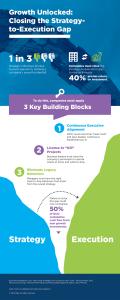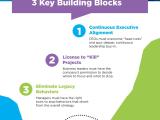Media Contact
Kelly Blum
CEB
[email protected]
571-303-5745
Closing “Strategy-to-Execution Gaps” Key Factor for Companies to Achieve Growth Targets
Execution Shortcomings May Cost as Much as 50% of Potential Cumulative Cash Flow on New Growth Investments According to CEB
Strategy shouldn't tie you up. Break free & unlock your growth potential. #CEBExecGuidance Tweet
With the average S&P 500 company needing to generate more than $1.05 billion in new revenue growth by 2016 just to meet shareholder growth expectations, being able to execute on new growth strategies is more critical than ever. Companies must think of ways to jumpstart organic growth and push past the competition by positioning themselves to effectively execute smart, new strategies. To address this, executives must unlock their organizational capacity – both the resources needed to effectively execute and the mental bandwidth that comes from stopping previous activities in order to take up new ones.
“Senior leaders attempt a variety of approaches to drive better strategy execution – such as more detailed or inclusive planning, executive strategy off-sites, or flatter organizational structures – however, these approaches often consume more management bandwidth as opposed to creating more capacity. To create the mental and organizational capacity to focus on new projects, business leaders must give managers a ‘license to kill’ old, obsolete projects that have proven unsuccessful or are no longer aligned to the organization’s strategy,” said Marc Austin, head of strategy research at CEB. “Leaders have to practice addition and subtraction if they want employees to be able to execute on new growth strategies.”
CEB’s Executive Guidance for 2015 reveals that in order to close the strategy-to-execution gap, organizations must better align executive leadership on strategic goals, empower business and functional leaders to terminate projects that no longer add value and discourage old behaviors that impede new strategies from taking hold.
- Manage Executive Alignment: CEOs must make sure the leadership team is aligned, ready and willing to tackle new strategies and continuously reinforce that alignment. A consistent, proactive approach is to needed to maintain alignment to new strategies.
- Provide A ‘License to Kill’ Projects: Business line and functional leaders must have the liberty to decide which initiatives to put on hold, or even get rid of, so that new strategies can be fully implemented. Doing so unlocks the capacity and the mental bandwidth managers need to focus on new efforts that support company strategy.
- Eliminate Legacy Behaviors: Front-line managers must be empowered to eliminate legacy behaviors among staff that are not aligned with the goals of new strategies. Additionally, they should articulate what behaviors employees should be focused on, providing a clear goal for them to work towards.
To learn more, download the Executive Guidance for 2015 or visit CEB.
About CEB
CEB, the leading member-based advisory company, equips more than 10,000 organizations around the globe with insights, tools and actionable solutions to transform enterprise performance. By combining advanced research and analytics with best practices from member companies, CEB helps leaders realize outsized returns by more effectively managing talent, information, customers and risk. Member companies include approximately 90% of the Fortune 500, more than 75% of the Dow Jones Asian Titans, and 85% of the FTSE 100. More at cebglobal.com.
SOURCE: CEB
Video Gallery
Photo Gallery
MPEG-4 Video
Right-click the button below for 'SAVE' options
Download Video


